Posted By John Sears on November 23, 2010
Well the trip to The Dark Carnival was tons of fun and went off without a hitch, right up until the day after we get back and I fall terribly ill while trying to get the media uploaded and some posts written about the trip.
Sorry about that.
We have returned from our triumphantly successful odyssey to Bloomington, Indiana, however, and the ZRC has a story to tell. The first, and main, batch of pictures is up on the flickr account now, and you can go look at them here. An overview of the whole shebang follows below, meanwhile.
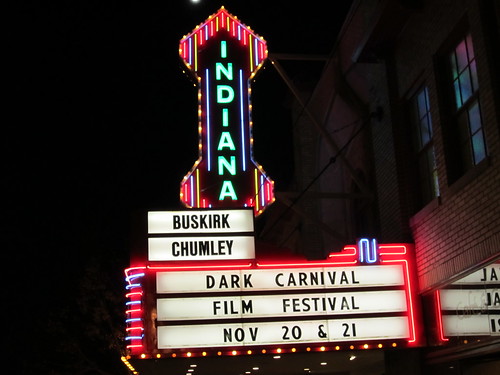
Relative newcomers to Zombie Rights or this blog might be asking, at this point, ‘What is The Dark Carnival Film Festival, and why is it so important to The Cause?’ Well, curious readers, The Dark Carnival is the premiere independent horror film festival in the United States, critically acclaimed and very well known for its emphasis on the films and filmmakers (rather than merchandizing, the driving force behind so many horror events). As a result, it is both a great place to get a feel for the current state of affairs in the media regarding Zombie portrayals and tends to provide an early peek at how Zombies will be treated in the near future from the cutting edge of American cinema. With all the filmmakers who typically show up to the DC it’s also a great chance to advocate on behalf of the Differently Animated and agitate for the production of more Pro-Zombie, Zombie Friendly works, explaining The Cause to people in a position to influence the way that society at large perceives the Differently Animated.
This makes it one of The Zombie Rights Campaign’s favorite venues for public appearances and advocacy.
This year we were able to attend the entire festival and see every single film we had not previously viewed, which is another big first.
Friday night the festival opened with screenings at the Bloomington Playwright’s Project and featured a costume contest along with a full slate of movies, including two directly related to our Zombie Rights mandate, Cabine of the Dead (previously reviewed here) and Closure, an Israeli Zombie-hating film. A review of that one will be up soon. (The ZRC particularly loved Satan Hates You, which isn’t about the Differently Animated at all but instead is a horror comedy in the style of browbeating Christianist propaganda like Jack Chick.)
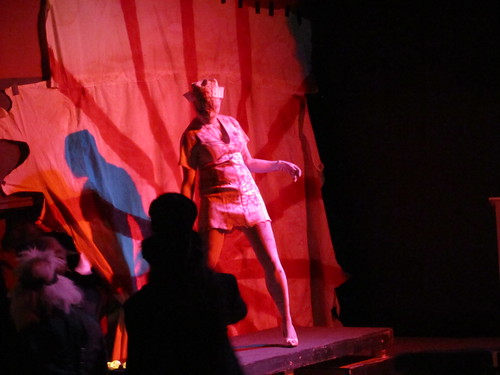
Here you can see the winner of the costume contest in her great Silent Hill getup. (Silent Hill is often lumped in with Resident Evil as they are both survival horror games, but Silent Hill features ghosts, delusions and demonic apparitions, not Zombies, so we’re more or less ok with it).
Friday night after the films there was an exclusive VIP banquet at the Scholar’s Inn, and the ZRC attended and talked Zombies and Zombie films with some of the attending luminaries. In particular we got to say hello to Deneen Melody and discuss the politics of W.O.R.M. with Anthony Sumner, which yielded some insight into how the creatures in W.O.R.M. came to be regarded as Zombies in the first place and the reasons behind marketing Slices of Life in part as a Zombie film, which is a fascinating topic for the ZRC: the construction of the Zombie identity in media.
Saturday was a full day of films and panels and discussions. We picketed against Cabine of the Dead, now that people had seen it at the festival and could appreciate its Living Supremacist stance for themselves. We saw a number of good movies, including fantastic faux-vintage film Maxwell Stein and three short films by Patrick Rea, including one thoughful short about vampires (thankfully non-sparkly) that makes me wish he’d do a Pro-Zombie piece at some point. Equal time, Mr. Rea?
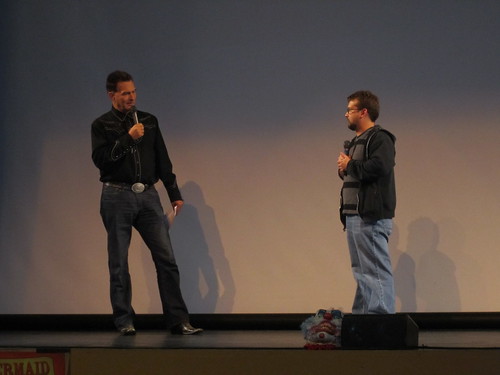
(Here you can see Patrick Rea doing a Q&A session with horror hosting legend and Dark Carnival special guest Joe Bob Briggs)
In the evening screenings we saw several noteworthy movies, like By Her Hand She Draws You Down, the latest from Anthony Sumner (not a Zombie picture per se but a character is definitely Differently Animated), Roses, the latest from Clockwerk Pictures (a review will go up for this movie soon) and The Prometheus Project, which is a retelling of the Frankenstein story updated for the modern era (review forthcoming).
Saturday also featured the Dark Carnival Awards ceremony, an event that the ZRC helped in its own small way to enable, sponsoring two awards ourselves, Best Supporting Actor and the annual Outstanding Achievement award. 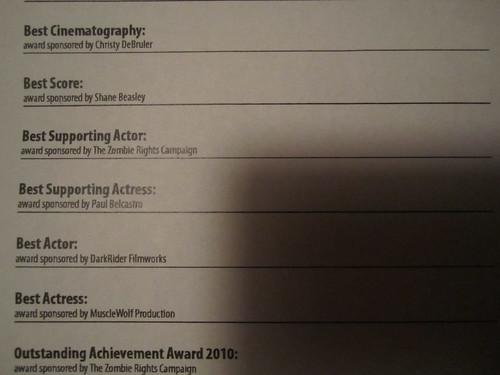
Since The Dark Carnival maintains complete editorial control over award nominations and the selection of winners, this could have presented an awkward situation for the ZRC, but fortunately our sponsored awards both went to deserving individuals without a lengthy history of Anti-Zombie activities. Alan Rowe Kelly won for Best Supporting Actor in Hypochondriac and Patrick Rea (whose short film about the menace of Girl Scouts, “Get Off My Porch”, is a ZRC favorite) won for Outstanding Achievement.
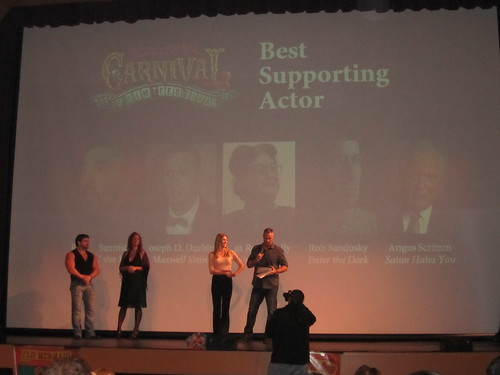
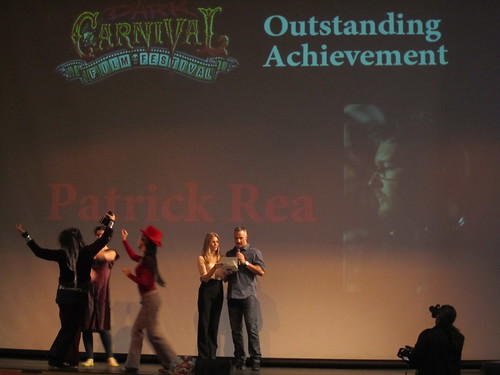
At some point we may want to discuss W.O.R.M. further with Mr. Kelly, however.
Saturday’s events also featured Baron Mardi winning another prestigious honor, as he is now the public face of indie horror filmmaking studio MuscleWolf Productions, selected by audience acclaim over several talented bodybuilders. This helps to illustrate the Baron’s magnetic personality and demonstrate how vital his work with the public can be for our movement.
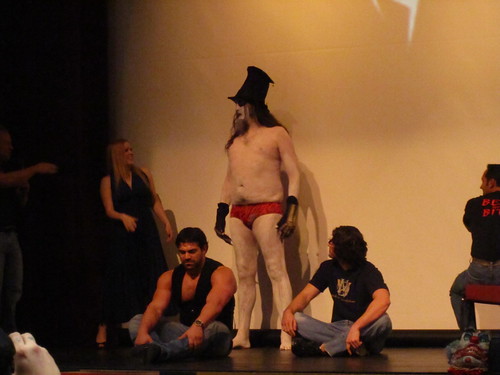
Saturday night concluded with the late night Adults Only screening, featuring some truly bizarre films. El Monstro Del Mar is a great Australian Grindhousey exploitation style film about awakening a malevolent Kraken, while The Taint is one of the strangest movies I’ve ever seen, where a plague of misogyny causes the end of civilization. Said end of the world scenario is utterly hilarious and graphically disgusting; you’ve never seen a movie quite like The Taint.
Joining the ZRC for this last set of screenings was longtime ZRC correspondent and Friend of Zombies everywhere, Michelle Hartz, who was nice enough to also give us a photo opportunity.
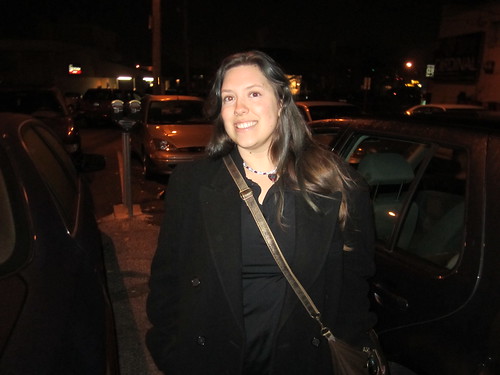
After grabbing a few hours sleep it was time to head back out Sunday morning. Before we went to the theatre, the ZRC engaged in a little pamphleteering, putting up some of our posters and informational brochures around town in the legally-designated spots, so as to be polite and avoid littering.
I think we got some responses too, as people were plainly taking brochures and posters down from where we placed them; no doubt to share their newly acquired wisdom with friends and family.
Back at the festival proper, Sunday’s screenings featured the aforementioned Hypochondriac, Marv Blauvelt’s project about a germophobic doctor attempting to practice medicine amongst a town of bizarre hillbillies’ House of Hope, a Bloomington, IN shot film about religious mania and kidnapping; Cyrus: Mind of a Serial Killer, starring The Lance himself, Lance Henriksen; as well as a particularly nasty and extremely short Anti-Zombie film called “Rise of the Living Corpse”.
Rise is less than a minute long, so I’ll probably put up a review of one sentence or less to be fair; it should never take longer to read a review than to watch the movie in question.
Sunday we also presented Baron Mardi with his Zombie of the Year award in person, and he was extremely happy to receive our prestigious honor. We’ll have a post with more on that, including a testimonial, very soon.
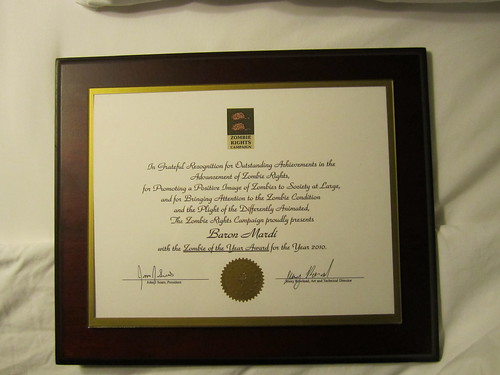
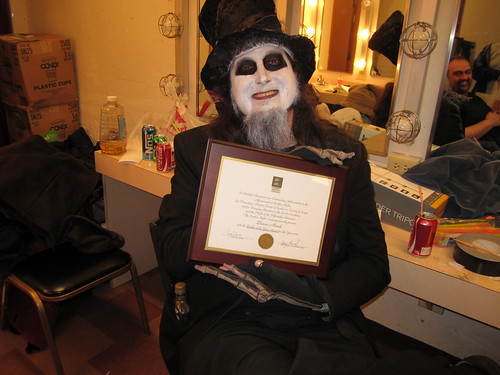
That about wraps it up for our overview post. Special ZRC thanks to The Dark Carnival, the Atomic Age Cinema monsters, Leya Taylor, Deneen Melody, Anthony Sumner, Michelle Hartz, Marv Blauvelt, Jason Hignite and many others.
Category: The Dark Carnival, Zombie Media, ZRC News |
No Comments »
Tags: Movies, Public Appearance, Social Justice, The Dark Carnival, Videogames, Zombie of the Year 2010














